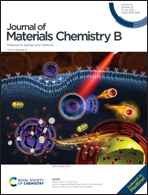Multifunctional silicon calcium phosphate composite scaffolds promote stem cell recruitment and bone regeneration†
Abstract
A scaffold is one of the most significant implants for treating bone injury, while the precise control of stem cell proliferation and differentiation within a scaffold is still challenging. In this work, a composite scaffold was designed to be capable of recruiting endogenous stem cells, stimulating osteogenic differentiation and achieving significant bone repair function. The designed SiCP + SF@PFS silica–calcium phosphate composite scaffold was obtained by mixing the peptide PFS containing silk fibroin solution with the SiCP scaffold, and treating with horseradish peroxidase and H2O2. The results showed that the composite scaffold was able to release the PFS peptide continuously to induce the migration of mesenchymal stem cells. Meanwhile, cell proliferation and osteogenic differentiation were also improved after being seeded on the scaffold. In the cranial defect rat model, the composite scaffold was able to recruit CD29+ and CD90+ cells one week after implantation around the injury sites. The results of Micro-CT, H&E staining, Masson's staining and immunohistochemical staining indicated that the composite scaffold was able to promote new bone formation significantly.



 Please wait while we load your content...
Please wait while we load your content...